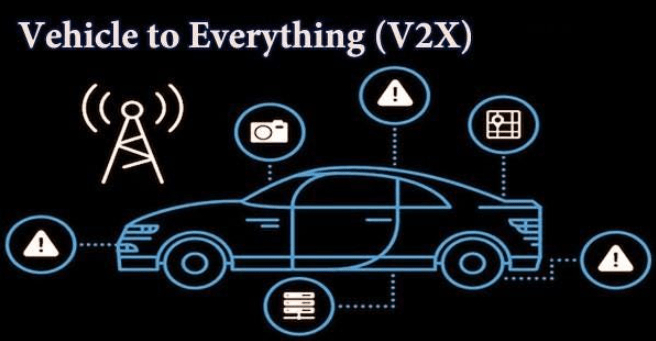Autonomous vehicles (AVs) are reshaping transportation by reducing human error, increasing efficiency, and connecting vehicles to surrounding infrastructure through Vehicle-to-Everything (V2X) communication. V2X enables vehicles to communicate with each other and nearby devices, improving safety, navigation, and real-time data sharing. However, this communication requires secure data exchange to protect sensitive information from hacking or manipulation. Blockchain technology offers a promising solution to ensure data integrity and security in V2X communication, providing a decentralized and transparent framework for data exchange. In this article, we’ll explore how blockchain supports V2X communication, ensuring the safety and reliability of autonomous vehicles.
What is Vehicle-to-Everything (V2X) Communication?
V2X communication enables autonomous vehicles to communicate with other vehicles (V2V), infrastructure (V2I), pedestrians (V2P), and networks (V2N). By integrating data from multiple sources, V2X improves navigation, enhances safety, and allows vehicles to respond to real-time road conditions. However, with increased data exchange, V2X communication is vulnerable to cyber threats, such as unauthorized access or data tampering. Implementing blockchain can provide the necessary security layer to ensure that the data exchanged is accurate, transparent, and immutable.
The Role of Blockchain in Securing V2X Communication
Blockchain’s decentralized architecture records transactions on a distributed ledger, making data secure, tamper-resistant, and accessible only to authorized participants. By applying blockchain to V2X, vehicles and infrastructure can verify the source of data, ensuring that it’s legitimate and not tampered with. Blockchain can also enable vehicles to store driving and communication data transparently, allowing regulatory bodies to verify compliance and track incidents if they arise.
For more on blockchain’s security benefits, check Google’s guide on Blockchain Data Security.
Key Blockchain Applications in V2X Communication
Blockchain technology offers various applications for V2X communication that help secure data and enhance reliability in autonomous vehicle systems:
- Decentralized Data Verification
One of the primary benefits of blockchain in V2X communication is decentralized data verification. Traditional systems rely on centralized servers, which are prone to hacking or system failure. Blockchain’s decentralized framework enables vehicles and infrastructure nodes to verify data without relying on a central authority, ensuring that data is authentic and reliable in real time. - Enhanced Security for Vehicle Data Exchange
Blockchain can secure sensitive data exchanged between vehicles, infrastructure, and other V2X components. For instance, a vehicle could send data on road hazards to other vehicles nearby, ensuring that the information is accurate and not tampered with. This layer of security helps prevent potential cyberattacks on autonomous vehicle systems, enhancing road safety. Companies like IOTA are exploring blockchain frameworks for secure data sharing in connected devices, making them valuable for V2X applications. - Smart Contracts for Automated Processes
Smart contracts are programmable agreements that execute automatically when certain conditions are met. In V2X communication, smart contracts can automate processes such as toll payments, insurance claims, and vehicle maintenance. For example, when an autonomous vehicle crosses a toll booth, a smart contract can automatically initiate payment, saving time and enhancing efficiency.
Advantages of Blockchain in Autonomous Vehicles and V2X Communication
- Transparency and Auditability
Blockchain’s transparent ledger provides an audit trail of all transactions, ensuring that every data exchange is recorded and accessible for verification. This transparency is essential for incident investigation, allowing authorities to trace the source of data and confirm its integrity. By providing a clear record, blockchain can help verify compliance with safety regulations and hold manufacturers accountable for security standards. - Data Privacy and User Control
While V2X relies on data exchange, blockchain enables data sharing without compromising user privacy. Autonomous vehicles can use blockchain’s permissioned access to control who views sensitive information, ensuring that only authorized parties, such as other vehicles or infrastructure managers, can access data. This secure, permissioned framework protects drivers’ privacy while enabling essential data sharing for road safety. - Enhanced Collaboration Between Stakeholders
Blockchain’s decentralized structure supports collaboration among various stakeholders, including vehicle manufacturers, insurance companies, and regulatory bodies. By providing a secure, shared database, blockchain enables these entities to work together more efficiently, exchanging data and information to ensure safe and compliant autonomous vehicle operations.
Blockchain Platforms Supporting Autonomous Vehicle Development
Several blockchain platforms offer tools that enhance V2X communication and autonomous vehicle data security. These platforms focus on transparency, data privacy, and interoperability:
- IOTA: Designed for the Internet of Things (IoT), IOTA supports decentralized data sharing, making it ideal for V2X communication in connected and autonomous vehicles. For details, check out IOTA’s Official Site.
- Ve Chain: Known for its secure and transparent supply chain solutions, Ve Chain can support data traceability in autonomous vehicle systems, ensuring accurate and reliable information exchange. Explore more on Ve Chain’s Official Site.
- Ethereum: Ethereum’s smart contract capabilities make it useful for automating processes such as insurance payments or tolls in V2X networks. Ethereum’s flexibility makes it suitable for multiple use cases in autonomous vehicle development. Learn more at Ethereum’s Official Site.
The Future of Blockchain in Autonomous Vehicle Security
As autonomous vehicle technology advances, blockchain is likely to play a vital role in ensuring data security and transparency in V2X communication. Blockchain provides a tamper-resistant record of data exchanges, enabling vehicles to interact seamlessly and safely with each other and surrounding infrastructure. Blockchain’s integration with V2X can help build public trust in autonomous vehicles by demonstrating that data integrity and privacy are maintained. However, challenges remain, including the need for scalable blockchain solutions and regulatory support to integrate blockchain within autonomous vehicle frameworks.
Conclusion
Blockchain technology holds significant potential for enhancing the safety and reliability of autonomous vehicles by securing V2X communication. From decentralized data verification to privacy protection, blockchain addresses key challenges in managing data exchange in autonomous vehicle networks. As blockchain applications expand, they are set to become a cornerstone in building safe, efficient, and connected transportation systems. Through blockchain-enabled security, autonomous vehicles can help cities improve road safety, reduce traffic congestion, and usher in a new era of smart, secure transportation.




